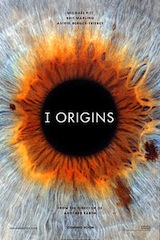 The dynamic between science and spirituality has been the focus of some of the most hotly contested debates in our culture. The debate continues today and that conflict is at the heart of writer/director Mike Cahill’s second film, I Origins a sci-fi love story that follows a promising young scientist as he begins to doubt his lifelong certainty that facts alone can explain everything around us.
The dynamic between science and spirituality has been the focus of some of the most hotly contested debates in our culture. The debate continues today and that conflict is at the heart of writer/director Mike Cahill’s second film, I Origins a sci-fi love story that follows a promising young scientist as he begins to doubt his lifelong certainty that facts alone can explain everything around us.
The movie won the Alfred P. Sloan Feature Film Prize at this year’s Sundance Film Festival. That prize is given each year to a feature film that focuses on science or technology as a theme, or depicts a scientist, engineer, or mathematician as a major character. Each winner is presented with a $20,000 cash award provided by the Alfred P. Sloan Foundation.
Fox Searchlight, which also distributed Cahill’s first feature, Another Earth, is distributing I Origins. The movie opened this past weekend in New York and Los Angeles and will hit the art house circuit July 25. The film is getting largely favorable reviews and some critics singled out the work of Cahill and his cinematographer Markus Förderer.
In the New York Times A.O. Scott wrote, “The action shifts from New York to New Delhi (both exquisitely shot with a Red Digital camera by Markus Förderer, the cinematographer).”
Brian Tallerico, writing for Ebert.Com went further: “Anyone who has known love can attest to its ability to forever alter a charted course and Cahill’s emotionally raw approach to filmmaking gets to the truth of that in a memorable way. It’s also a remarkably confident film technically. Cinema has had a love affair with the eye for a century now and Cahill and cinematographer Markus Förderer take the timeless image of the eye and give it emotional resonance in the way they use it, balancing the film's two equally important halves.”
The movie tells the story of Dr. Ian Gray (Michael Pitt), a molecular biologist studying the evolution of the eye. He finds his work permeating his life after a brief encounter with an exotic young woman Sofi (Astrid Bergès-Frisbey), who slips away from him. As his research continues years later with his lab partner Karen (Brit Marling), they make a stunning scientific discovery that has far reaching implications and complicates both his scientific and spiritual beliefs. Traveling half way around the world, he risks everything he has ever known to validate his theory.
“For generations, the eyes have been called the windows to the soul,” says Cahill. “Think about it. We each possess these magnificent artworks on the front of our face. They are all beautiful, if you look very closely at them. In 1987 a professor at Cambridge University named John Daugman gave that poetic belief a basis in science when he discovered that each human being has a unique and measurable iris pattern, not unlike a fingerprint.”
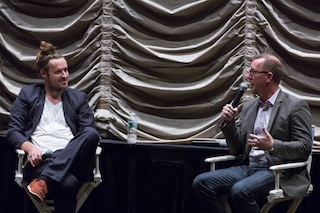 I Origins was the first film to receive the support of the Dolby Institute. Dolby created the Dolby Institute to educate and inspire content providers to use the power of audio and visual technologies in all their projects. "The Dolby Institute engages artists by providing education, inspiration, and support throughout the creative process," says Glenn Kiser, the Institute’s director. "We encourage thinking creatively about sound and visuals as storytelling tools from the beginning."
I Origins was the first film to receive the support of the Dolby Institute. Dolby created the Dolby Institute to educate and inspire content providers to use the power of audio and visual technologies in all their projects. "The Dolby Institute engages artists by providing education, inspiration, and support throughout the creative process," says Glenn Kiser, the Institute’s director. "We encourage thinking creatively about sound and visuals as storytelling tools from the beginning."
The Dolby Institute recently hosted a screening of I Origins at Dolby’s headquarters in New York. Afterward Kiser moderated a Q&A session with Cahill. I was there and several days later I also interviewed Cahill by phone. What follows combines his remarks from both the screening Q&A and that interview.
Cahill, who continues to be fascinated by science, earned a degree in economics from Georgetown University. Two of his siblings are scientist and he jokes that he’s the black sheep in the family. He’s always been drawn to science fiction films, and says, “I like minimalist sci-fi stories.” He says I Origins started with a concept but that he knew from the start that he wanted the I Origins story to also be a love story because he wanted a chance to portray scientists who are also attractive sexy people. Cahill got the inspiration for the concept, curiously enough, while he was looking at dinosaur footprints near Roman ruins. He saw small children playing in the depressions and thought it was unlikely that those children and possibly their ancestors understood what had made those depressions. He asked himself, “What are our dinosaur footprints? What aren’t we seeing?”
After researching various topics he instinctively settled on the human eye as the central mystery in his story. The eyes are unique and, he says, “They make a really great canvas for a movie and a love story.” Also, as a culture we still have much to learn about their inner workings.
From a scientific point of view, the eye is an intricate, complex machine. Says Cahill: “It has an iris, a pupil, a retina, an optic nerve, sclera and various muscles. Each has specialized functions and work together seamlessly.”
There are three critical scenes in the film that also all presented the filmmakers with serious creative and technical challenges.
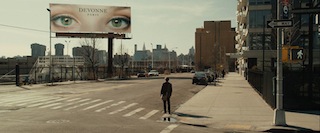 Very early in the film Dr. Gray takes a break from his research to attend a Halloween costume party in a Downtown New York loft. It says a lot about his personality that he wears his lab coat to the party and goes as a scientist. The place is crowded, the noise deafening. Dr. Gray escapes to the roof for a cigarette and meets an alluring woman whose costume covers her head to toe. Only her beautiful eyes are showing. In her alluring voice she says she has come to the roof to look at the full moon and bask in its mystery. Too rationale for that conversation, he tells her about his work and, with her permission, photographs her eyes for his collection. Soon they are together in the loft’s bathroom having passionate sex. All is going well until he asks her name and she runs away.
Very early in the film Dr. Gray takes a break from his research to attend a Halloween costume party in a Downtown New York loft. It says a lot about his personality that he wears his lab coat to the party and goes as a scientist. The place is crowded, the noise deafening. Dr. Gray escapes to the roof for a cigarette and meets an alluring woman whose costume covers her head to toe. Only her beautiful eyes are showing. In her alluring voice she says she has come to the roof to look at the full moon and bask in its mystery. Too rationale for that conversation, he tells her about his work and, with her permission, photographs her eyes for his collection. Soon they are together in the loft’s bathroom having passionate sex. All is going well until he asks her name and she runs away.
Dr. Gray becomes obsessed with finding her again but the only clue he has is the picture of her eyes. He obsesses over the image to the point that his new lab assistant, Karen, mentions it. A few days later, while out buying cigarettes and a lottery ticket the number eleven begins to appear seemingly everywhere and he follows their trail. Is this an act of faith or a realist trying to solve a puzzle through research? Cahill doesn’t answer that question. Dr. Gray inevitable gets on a Number 11 bus and rides it wherever it takes him. He takes yet another number eleven on the street as a signal to get off the bus and the scene is set for the first critical scene and a very complicated shot.
Cahill says he knew he wanted to use a version of Hitchcock’s Vertigo shot for the scene as soon as he wrote it. “Here was this visceral moment,” he remembers thinking and that shot seemed ideally suited to the moment.
Irmin Roberts, a second unit cameraman from Paramount Pictures, is credited with developing the shot when he was working with Hitchcock on Vertigo in 1958. The two men wanted to capture the unpleasant physical sensations that can often accompany the fear of falling. The effect is achieved by moving the camera in one direction as the lens zooms in the opposite direction. It has been copied countless time, perhaps most notably when Steven Spielberg used it in Jaws to capture Roy Scheider’s character’s reactions on the beach when he sees the shark for the first time. “Hitchcock was a genius,” says Cahill. “He saw the limitations and pushed it forward. I’m standing on the back of all those filmmakers.” Cahill added to his own challenge deciding to incorporate the dolly zoom with a 180-degree turn.
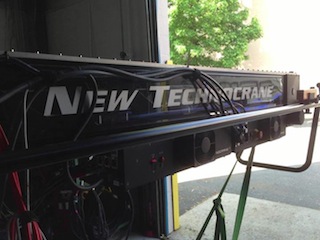 As Dr. Gray steps off the bus in a strange neighborhood he stands on the sidewalks for a moment as he starts to get his bearings. He turns back to the bus and he sees something that amazes him. There, reflected in the bus window, are the woman’s eyes. The camera is behind him and we see what he sees. The shot showing his reaction to her eyes in the bus window is when things begin to get complicated. We next see him from behind and the camera begins a 180-degree turn with him to completely reveal the billboard. Her eyes are the main feature of a sophisticated perfume ad. As he stares the camera moves in and the zoom lenses pulls out until the billboard all but fills the screen with Dr. Gray standing and staring in the foreground.
As Dr. Gray steps off the bus in a strange neighborhood he stands on the sidewalks for a moment as he starts to get his bearings. He turns back to the bus and he sees something that amazes him. There, reflected in the bus window, are the woman’s eyes. The camera is behind him and we see what he sees. The shot showing his reaction to her eyes in the bus window is when things begin to get complicated. We next see him from behind and the camera begins a 180-degree turn with him to completely reveal the billboard. Her eyes are the main feature of a sophisticated perfume ad. As he stares the camera moves in and the zoom lenses pulls out until the billboard all but fills the screen with Dr. Gray standing and staring in the foreground.
“The technology to pull this off is new,” Cahill said. To accomplish it he rented a Technocrane from Monster Remotes. “There are only two in the country – one in Los Angeles, one in Hoboken – and they rent for $10,000 a day. “So we rented one for five minutes,” he laughs. The Technocrane stands almost seven feet high, can extend vertically more than 21 feet and has a telescopic range of more than 15 feet. Since Cahill rented his the company has moved its New Jersey location to Union City.
Cahill knew he wanted the camera to dolly in and zoom out once Dr. Gray makes his turn. “It pulls the background closer,” says Cahill. He wanted to emphasize the large billboard with the eyes and the emotional pull they have for Dr. Gray.
“It took a lot of planning and a lot of calibration,” he says. He and Förderer started they’re plotting with frame one of the shot and worked their way through methodically through to the final frame. The crane is run by computer says Cahill “and once you design the shot and program everything in you just hit the Go button. We did ten takes for safety but we got the shot on the second take.”
The Dolby Institute’s support was critical to the film because it enabled Cahill to mix in Dolby Atmos at Skywalker’s facilities in Marin County. “Atmos opens up amazing possibilities,” Cahill says. The Atmos sound mix was particular important in the other two critical scenes: the open market scenes in Act Three in India and the pivotal elevator scene that is one of the emotional high points of the film.
With the information he gets from the billboard ad Dr. Gray is finally able to track down the mysterious woman with the beautiful eyes. She is a free-spirited model named Sofi and they fall in love. They’re love story encompasses Act One. Their relationship takes a shocking turn one evening during an argument in the elevator to her loft. Cahill calls it one of the most difficult scenes in the film, not simply because of the technical challenges but because of the complex physical and emotional demands it placed on the two actors. Using Atmos sound, Cahill and sound designer Steve Boeddeker puts the audience inside that elevator as it rises and the two lovers argue. When the elevator jams and screeches to a jolting stop you can almost feel it as the tension increases. Saying more about the scene would spoil it for the people who haven’t seen the film but adding greatly to the drama and emotion is the fact that the final seconds of it take place in complete silence.
Cahiil credits Boeddeker with that decision and calls it “a visceral thing, the result of a lot of trial and error.” They had tried many variations of the sound mix for the scene but nothing felt right to either Cahill or the sound team. Cahill says he makes all the final decisions but he’s content to let the creative people around him do their work without micromanaging them. He says Boeddeker called him one afternoon to say he was sending him a new mix of the elevator scene and what did Cahill think. It was the silent version and Cahill loved it. “I did extensive research on the science of the entire story and I learned that there is evidence that people in shock typically experience a significant feeling of hearing no sounds at all for a brief time.”
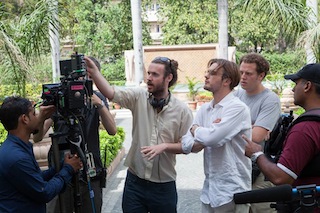 If the elevator scene was closed in and private the final scenes, which take place is India, were the exact opposite. The decision to shoot most of Act Three in India was another one that Cahill says he made as he was writing the script.
If the elevator scene was closed in and private the final scenes, which take place is India, were the exact opposite. The decision to shoot most of Act Three in India was another one that Cahill says he made as he was writing the script.
India, despite its distance and the myriad complications involved in shooting there, was the ideal place to resolve Ian’s search, says Cahill. “I wrote the third act to take place in India because we are dealing with science and spirituality,” he explains. “The particular science we’re dealing with is the uniqueness of the eyes and iris scanning. The particular spirituality we’re dealing with is the soul. In India, the transmigration of the soul is taken for granted. But at the same time, they have a unique ID program to scan every single citizen’s eyes in India.”
By this time in the film Dr. Gray and his former lab assistant Karen are married and have given birth to a son. Shortly after his birth, they agree to allow the hospital to scan his eyes. That scan reveals a possible health problem for their son, but it also reveals that he is somehow related to a Black man from the Midwest. As scientists the determine to find out what is actually going on and in doing their research they discover someone in India with the exact same eyes as Sofi. Scientifically, this is impossible.
Much of Dr. Gray’s search in India occurs in an open market. Cahill credited the Dolby Atmos sound mix with “making you feel as if you’re really in that market.” Several scenes are shot there and they all required multiple takes. Cahill says the final, pivotal scene required twenty-eight takes. There were so many variables on the set that the sequence posed a big challenge. The production drew large, curious crowds of onlookers and “people looking in the camera” was a serious problem. This also presented issues for the sound crew who wanted to get clean recordings of all of the dialogue without sacrificing the sound designer’s desire to capture authentic ambient sound. The final mix is a testament to the talent and patience.
Dealing with those issues was not the only difficulty with the final scene. When Dr. Gray at last finds the little girl whose eyes match Sofi’s, they have to appear to be a genuine match. Cahill says matching the eyes in the film was a “huge challenge” and to achieve the results he wanted required “two hundred visual effects.” Essentially what they ended up doing was the use the images of Astrid Bergès-Frisbey’s eyes, the actress playing Sofi, and digitally inserted them into the little girl. Cahill gives all the credit to the visual effects crew, led by Michael Glen, with making the match seem real.
Cahill has no illusions that his film will end the debate between science and spirituality. He likes to quote Albert Einstein who wrote on that subject: “Everyone who is seriously involved in the pursuit of science becomes convinced that a spirit is manifest in the laws of the Universe—a spirit vastly superior to that of man, and one in the face of which we with our modest powers must feel humble.”
